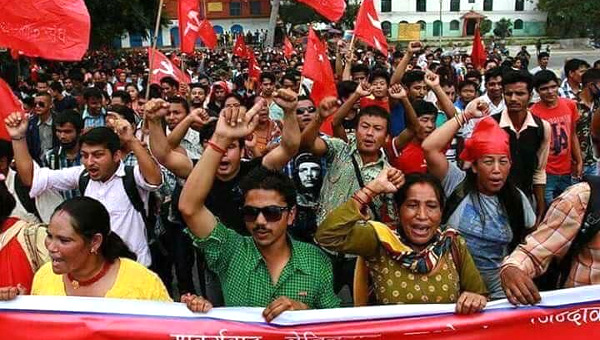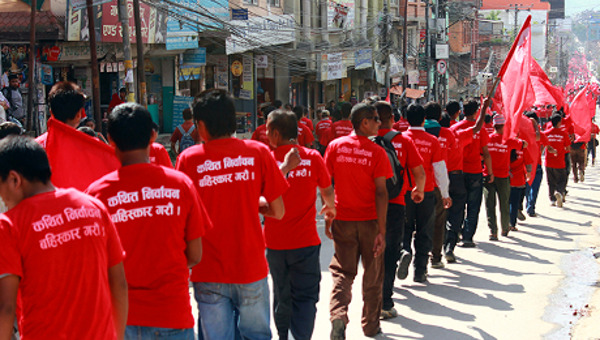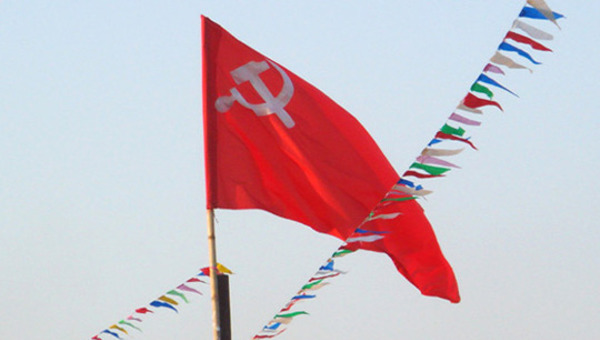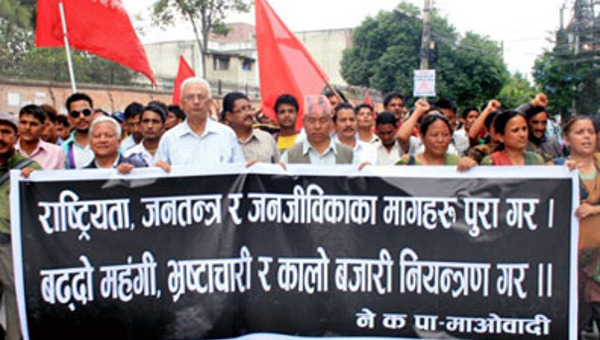Heyday for Nepali Communists
Communists have won a landslide victory in the elections for House of Representatives of Federal Democratic Republic of Nepal held in two phases on 26th November and 7th December 2017. In a parliament of 275, the elections were held for 165 seats under the first past the post system (FPTP) and the rest, 110 seats, were by proportional system. Farooq Tariq visited Nepal for four days after the election results were announced from 13/17 December 2017 and reports.
The Communist Party Nepal (Unified Marxist Leninist UML) won 80 seats under FPTP while their Left Front partner CPN (Maoist Center) won 36 seats. The ruling Nepali Congress (NC) could gain only 23 seats. The Communists won 116 seats out of 165 in total. Two parties based in Madhes, in southern Nepal, the Rastriya Janata Party-Nepal (RJPN) and the Sanghiya Samajbadi Forum (SSF), combined to secure 21 seats; other fringe parties won the remaining five seats.
In the proportional system for the 110 seats, UML got 33.25 per cent vote while Congress came second with 32.78 per cent. The Maoist Center got 13.66 per cent votes.
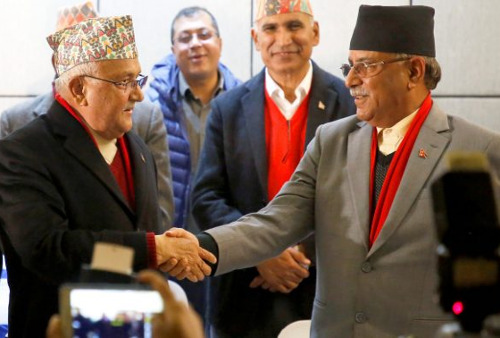
In total, out of the 275 seats in the House of Representatives, the left alliance holds 174 (121 for the CPN-UML and 53 for the Maoists), the NC 63, the RJPN 17, and the SSF 16.
The Congress was at the losing end in the FPTP system as the Communists united and put up joint candidates under a 60/40 formula in favor of UML. It was mainly one-against-one race in the elections under the new 2015 constitution that made the difference in favor of Communists unlike the past parliamentarian practices, when three main parties were contesting against each other during the last 2013 and 2008 general elections.
The newly constituted seven provinces also saw a massive victory for UML. Six out of seven provinces were won over by UML and the process of forming new provincial governments is under way.
The two main parties of Nepal, UML and Maoist Center, had decided prior to the elections, not only to form the alliance but also to merge within six months to form one united Communist party. This was approved very well by the people as this brings the two parties into a binding contract to unite and not just an election alliance.
There were celebrations in the street of the Katmandu after this historic victory of the Communists. This was the first time that Communists have an almost two third majority in Nepal, the most poverty stricken country of South Asia. The UML and Maoist Center have been in power several times since 1994 but always for a short time and as part of coalitions.
The appeal of UML for a stable and strong government worked very well among the Nepali masses who were tired of weak coalition government of opposite ideologies. The Nepali Congress was also taught a lesson for their impression of a pro-Indian party.
The Indian Blockade
India’s blockade of September 2015 was remembered very well by Nepali masses who had to make kilometers of lines to fetch petrol for vehicles after most supplies from India were stopped.
This was after the Madheshi community protested over the issue of constitutional rights. Madheshis are mainly located in Terai area of Nepal and were unhappy with the rights they had within the first constitution of Nepal. The blockade choked imports of not only petroleum, but also medicines and earthquake relief material. The United front of Madheshi parties could win only one province and around 10 per cent of the total votes during the present elections.
During the election campaign, Nepali Congress leaders said that a victory by the left alliance would bring a totalitarian regime to power; that a one party system and age old communism has failed miserably in the world. These arguments failed to impress the general public. Over the last three decades, the CPN-UML has transformed itself into a democratic force; voters were not convinced that its victory would lead to one-party communist rule. UML at best could be termed as left social democrats. They had adopted multi-party system in their constitution.
Women’s Participation
A total of 41 women candidates contested in the first round of elections to the House of Representatives and State Assemblies, in 32 districts out of 75. Of them, 18 women are contesting in the House of Representatives and the rest in the State Assemblies. Only five women won the elections in the FPTP system on the open seats contest. The Nepal constitution guarantee at least 33 per cent of women’s representation in the parliament – that means 91 women in a parliament of 275. Only five were elected, rest of the 86 women would be elected through the proportional system to qualify the general election in accordance with the constitution.
The UML Leadership
The UML is led by KP Sharma Oli (65) who joined the Communist movement at the age of 13. Inspired by Indian Communist leader Charu Majumdar, known as “father of Naxalbari peasant movement of Bengal” he spent fourteen consecutive years in jail from 1973 to 1987. He was elected Member of Parliament for the first time in 1991 then 1994 and 1999. He lost to Maoists in 2008 general elections but won comfortably in 2013 and 2017. He has served in important ministries during the past 21 years and was also Prime Minister of Nepal from October 2015. He resigned in August 2016 after the Maoists ditched the Left Alliance government to join the Congress. Pushpa Kamal Dhar, known as Prachanda, leader of the Maoists, was elected Prime Minister. However, before the present elections, Prachanda opted to form the Left Alliance and won 36 seats in the FPTP system and around 13 per cent of the votes in PR system.
A Short Note on History of Communists
Nepali Communists are not traditional communists. Realizing the negative effects of the collapse of the Soviet Union, CPN UML was formed on January, 1991 through the unification of the Communist Party of Nepal (Marxist) and the Communist Party of Nepal (Marxist-Leninist). The party has led four governments before the present landslide victory. The UML surprised many internationally, when they took over power for the first time briefly for nine months through elections in 1994 at the time when there was massive propaganda against socialism. Many brushed aside this victory as “communists governing under a king.”
In this present period of right wing surge, it is very pleasant to see that Nepal is a sizable country where Communist parties of various stripes cumulatively enjoy the support of the majority of the country’s voters – even if it is the only remaining one.
However, this is not an accidental landslide victory of the CPN UML and Maoist Center. It took years of hard work with a Nepali touch unlike the other CPs of the region that they were able to keep, sustain, consolidate and muster this mass support of the working class. The Communist Party Nepal formed in 1949, in India, has gone through various phases of development, from being a party in exile to a party with significant presence in every part of Nepal. It has seen dozens of splits within its ranks and has allied to various international trends within the communist movement. However the urge of unity among various factions and groups which identify as Communist was always at the centre of their strategy.
From Maoism to Left social democratic ideology, from armed struggle to parliamentarianism, from war to peace, the Communists of Nepal in various forms were always known as communists. This identity as Communists has been very strong among their ranks and with good reasons. The term never brought them a negative response. It was always a vote winning term.
The predecessors of UML and Maoist Center have always learned to live and survive in most difficult circumstances and keep their support intact. While all political parties were banned between 1960s – 1980s, they managed to work along with the dictates of the King. They worked through Panchayats established as an alternative to parliament1 and tried to popularize their ideas. The main debate among them was how to be popular among the masses with their own name.
The decade’s long rift between the Kingdom and the Congress, the main party of the bourgeoisie, was very well maneuvered by various groupings of Communists in their favor. They sided one against the other. However, most of them were never afraid to go to jail. And many spent years behind bars.
The Maoists
The Maoists, during 10 years of armed struggle from 1996 to 2006, used a combination of armed attacks on police and official buildings and personnel while negotiating with the government and the King. The rejection of negotiation was not written in the dictionary of their strategy. So was UML leadership who was always ready to find a way out of the crisis.
It was the Maoist determination to abolish the office of the King that won the day after the 2008 parliamentarian elections when Maoist emerged surprisingly as the second largest party trailing behind Congress. This was a great victory for Nepal to get rid of the King through a combined strategy of mass movement and elections.
After abolishing the office of the King, the main challenge was writing a new constitution that could guarantee all the basic rights of all the communities, no matter how small. The challenge was not met without years of negotiations and sacrifices of various governments.
Maoist splits continued during the 2008/2013 power period through coalition governments along opposite parties and fellow Communists. They were bitterly divided on the issue of the path of the ‘revolution’. One faction of Maoism advocated a boycott of 2013 election, a strategy that failed miserably. However the damage was done as Maoists emerged as third party rather than the second position they had before, losing a significant layer of mass support to the UML.
Maoists under the charismatic leadership of Prachanda made various overnight U-turns in terms of forming coalitions and alliances. However, the cleverest timely move by the Maoist Center was to form an election alliance with UML prior to the 2017 elections and decide to start a merger process of the two parties. Had they not made this move, they would have lost badly in the present elections. A political scenario of a three way race in the present election would have benefited the Congress and thus another unstable government, probably based on another kind of alliance.
The Constitution
The year 2015 saw the acceptance of the constitution with 90 per cent parliamentary support. The yearlong boycott of Madheshi parties and the economic blockade of Nepal by India was well fought by the vast majority of Nepal. They succeeded in bringing back the Madheshi parties to main stream politics by making some amendments to the constitution in agreement with those advocating the boycott.
A Positive Development and Real Challenge
The Communist’s alliance landslide victory is a positive development in the South Asian region. It is like a wave of fresh cool air in an over-heated region of the Indian subcontinent. The real challenge begins now. The massive victory has raised massive expectations. Reforms are on the agenda. However, reforms under capitalism can never be of permanent nature. The capitalist path in the longer run is a road to distraction and losing mass support of the Communist’s ideology. They have to move ahead on the road of parliament to abolishing capitalism and remaining elements of feudal society. They know best how to do it, if they want to do it. •
This article first published by International Viewpoint.


